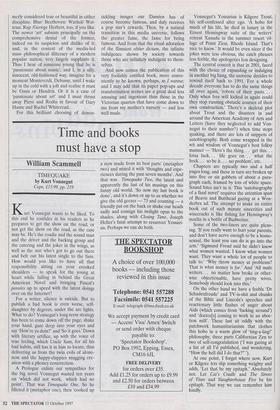Choosing the images
Hilary Corke
I WANT TO SPEND THE REST OF MY LIFE EVERYWHERE, WITH EVERYONE, ONE TO ONE, ALWAYS, FOREVER, NOW by Damien Hirst Booth-Clibbom, £59.95, pp. 334 And, one might well add, 7Ib 14oz, not to mention seven foldies, 23 die-cuts, seven pop-uppies, x slidies, y spinnies, z poly- thene sandwiches and 'a free-gift poster'. Over 700 colour illustrations. Text printed in white-on-black, yellow-on-brown, pink- on-puce, sideways, upside-down, reversed, mirrored, on top of other text, too small to read, too big to read, too crowded to read, too spaced-out to read, and by a confused baboon on a terminally gash typewriter.
Not a user-friendly book, even if one could lift it: more user-aggressive. A triumph of presentation then, a magnum- compendium of production values; but also a vast, exhaustive, exhausting catalogue raisonne of our Damien in all his avatars, the Shiva of the surgical-instruments cabinets, the 'pharmacies', the spot- paintings, the trash-buckets of fag-butts, the technicolour close-ups of the fatal wounds of suicides, the horrors out of chainsaw into formaldehyde. Dr Jekyll and whatever else, it amounts to a formidable body of exact instruction. Ignorance is no plea.
Ignorance is no plea. 'I can't wait to get into the position where I can make really bad art and get away with it.' It is only autobiographical in the way that wiping your bottom is a self-portrait.' I believe that after Pollock created a distance between the brush and the canvas by fling- ing the paint, there was nowhere to go with painting.' In its reckless innocence it is almost endearing. Take for example such a `spot-painting' as that entitled `Alprazolam (8-chloro-1-methyl-6-phenyl, 4H-1, 2, 4- triazolo [4, 3-a]-1, 4-benzodiazepine)'. If a chemist were commanded to make a paint- ing of Alprazolam, he would put down a large constellation of spots, variously sized, variously coloured, variously oriented, between them he would complexly string a cat's-cradle of many lines to represent the bonds: he would have created a molecular diagram. But Hirst just sets out a simple foursquare grid of unconnected, plain, circular dots, with colours meaninglessly chosen. It is one of more than a couple of hundred such, all toilsomely filled in and each purporting to represent a different pharmaceutical drug. Similarly, each of a series of 12 bulls' heads in formaldehyde is arbitrarily labelled with the name of one of the 12 Apostles. But the skull called 'Peter' doesn't 'look like' Peter any more closely than the skull next door. It is all child's play in a sense quite different from that in which it is child's play to make really bad art and get away with it. All this, though, is a description of the 'art' of Hirst, not a condemnation of it: the crudity is the skill and the pointlessness is the point.
Traditionally the artist moderated and sufflated reality to make unique images out of it. For the best part of a century, though, an alternative strategy has been laid open to him: he may simply elect his images rather than create them. Thus the urinal of Duchamps. In this sense (supposing it is valid) Hirst is one of the finest of contemporary artists, an inspired chooser and preserver of images beyond compare. His 'works', though, are, to beg a couple of terms, not art-objects but objets tout simples. Half a cow, for instance, is an exemplary object for the museum of the Royal Society of Veterinary Surgeons, and a urinal is an exemplary object if you need a pee. Indeed Hirst has worked very much harder than Duchamps, who had only to drop into the depot of his friendly neighbourhood urinal-monger. But these things in no sense breathe, remaining wholly untransfigured in themselves, modulated solely by the expectations in the minds of those who have first been instructed what to think about them.
Hirst is exactly a pop star, given that he works in the plastic and not the aural mode. The pop star machinates his gobbets of aural stuff and Hirst his visual stuff, by machinating as a verb transi- tive implying 'working as a machine and through other machines'. The end-products of these machinations emanate as things as far removedas may be from what was for- merly considered true or beautiful in either discipline. Blur/ Beethoven: Warhol/ Wat- teau: Rap /George Herbert, too, if you like. The newer 'art' subsists principally on the comprehensive denial of the former, indeed on its suspicion and dislike of it; and, in the context of the media-led mass philosophical illiteracy of a modern popular nation, very largely supplants it. Thus I hear of someone young that he is 'passionate about music', and I, in a silly, innocent, old-fashioned way, imagine for a moment Monteverdi, Debussy, until I wake up in the cold with a jolt and realise it must be Oasis or Hendrix. Or it is a case of 'passionate about art' and I must thrust away Piero and Rodin in favour of Gary Hume and Rachel Whiteread.
For this brilliant choosing of demos- tickling images our Damien has of course become famous, and duly receives a pop star's rewards. Then, by a natural transition in this media universe, follows the greater fame, the fame for being famous. And from that the ritual adoration of the flimsiest obiter dictum, the infinite indulgence shown by society towards those who are infinitely indulgent to them- selves.
And now comes the publication of this very foolishly entitled book, more conve- niently to be known, perhaps, as 1 wanna; and I may add that its paper pop-ups and transformation scenes are a great deal less amusing and ingenious than those in the Victorian quartos that have come down to me from my mother's nursery — and less well made.



















































































 Previous page
Previous page